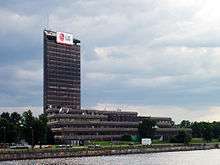Latvijas Televīzija
 | |
| Type | Broadcaster (Television, Radio & Online) |
|---|---|
| Country | Latvia |
| Availability | Latvia |
| Slogan | Skaties tālāk (Look Further) |
| Owner | Government of Latvia |
Key people | Ivars Belte (Chairman of the board) |
Launch date | 1954 |
Channels | LTV1, LTV7 |
Official website | ltv.lsm.lv/ |
Latvijas Televīzija (English: Latvian Television, LTV) is the state-owned public service television company in Latvia.
The company is funded by grant-in-aid from the Latvian government (around 60%), with the remainder coming from television commercials. Although moving LTV to licence fee funding has long been debated, this has been consistently opposed by the government. Many media analysts believe that the real reason for this is that the government is reluctant to lose the control of LTV that state-funding gives the government.
LTV operates two channels, LTV1 in Latvian and the LTV7 (previously called LTV2) in Latvian and Russian. LTV1 is the annual broadcaster of Eurovision in Latvia, and LTV7 also broadcasts many sport events like the Olympics, different Latvian sport league and national team games, MHL, Euro and FIFA World Cup.
The company is a member of the European Broadcasting Union, having joined on 1 January 1993. LTV hosted the annual Eurovision Song Contest in 2003, as well as the IIHF Men's Ice Hockey Championships in 2006 and the inaugural Eurovision Choir of the Year competition in 2017.
History
1954 to 1993
First test broadcasting started on 6 November 1954 in black-and-white and it was seen only by 20 television owners. It is the first and oldest national television station in the Baltic countries. Regular broadcasting started on 20 November 1954. At the start, LTV didn't have rights to create their own programming. In 1955 Riga's Television studio was created and since then programming was created by the studio.
On 19 March 1958, the first evening news show went on air. In 1963, it was renamed to Panorāma, as it is known to this day. A second TV channel was launched in 1961 and both channels converted to SÉCAM color in 1974.
1993 onwards

On 1 January 1993, Latvian Television and Radio Latvia became members of the European Broadcasting Union (EBU). On 2 February 1998, LTV along with LNT, Channel 31 (now TV3) and TV Riga (later TV5) converted to PAL color.
In 2008, LTV started broadcasting in digital terrestrial TV standard in MPEG2 format, changing to MPEG4 format on 1 August 2009 as the telecommunications company Lattelecom has been chosen to be the official integrator of digital terrestrial TV in Latvia. Analogue distribution of LTV7 finished on 1 March 2010. LTV completely finished broadcasting LTV1 in analogue format on 1 July 2010. Both LTV channels are also available on the Sirius satellite's Nordic beam as part of the Viasat package.
LTV changed its aspect ratio from 4:3 to 16:9 in 2003.[1] Since 2013 it has come under the umbrella of Latvian Public Broadcasting along with Radio Latvia, as part of the unification of both public broadcasters. LTV and Radio Latvia now share one news portal, LSM.lv, and an online streaming service (REplay.lv), with content from both broadcasters.
In 2017 LTV launched the online channel Visiem LTV (also styled VISIEMLTV.LV) for foreign viewers, mostly targeted for the Latvian diaspora. The programming is a mix of LTV1 and LTV7 broadcasts that are not restricted by copyright laws and are available globally.[2]
Logos
 Latvijas Televīzija (LTV1) logo (2017—)
Latvijas Televīzija (LTV1) logo (2017—) Latvijas Televīzija (LTV1) logo (2013—2017)
Latvijas Televīzija (LTV1) logo (2013—2017) Latvijas Televīzija (LTV7) logo (2012—)
Latvijas Televīzija (LTV7) logo (2012—) The previous Latvijas Televīzija (LTV1) logo, used 2006—2013.
The previous Latvijas Televīzija (LTV1) logo, used 2006—2013. The previous Latvijas Televīzija (LTV1) logo, used 2003—2006.
The previous Latvijas Televīzija (LTV1) logo, used 2003—2006.
See also
References
- ↑ https://www.youtube.com/watch?v=Ctw_jFyYrnk&ab_channel=ltvpanorama LTV1 maina attēla malu attiecību uz 16:9. ltvpanorama on YouTube.
- ↑ "VISIEMLTV.LV - jauns interneta televīzijas kanāls latviešiem ārzemēs".